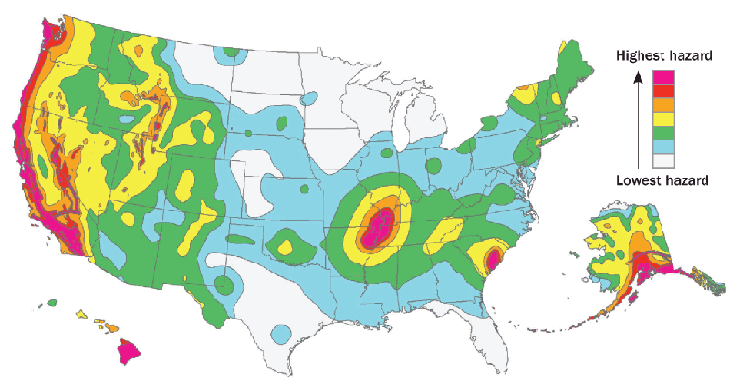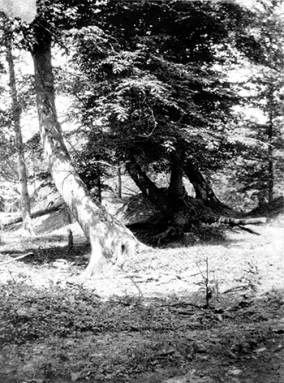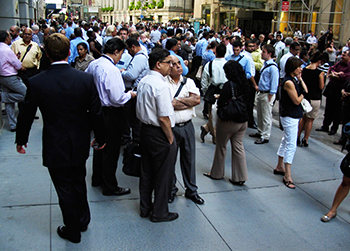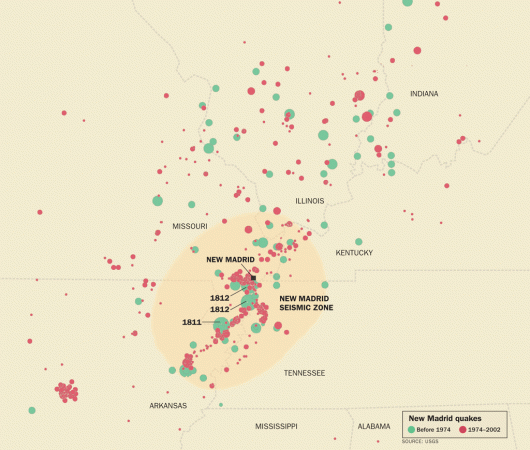Eastern quakes can trigger big shakes
Scientists study the widespread impacts of tremors east of the Rockies

Many people think just of California when discussing major quakes in the contiguous United States, but the Midwest’s New Madrid Seismic Zone and coastal South Carolina face similar threats.
USGS
By Sid Perkins

Researchers at the U.S. Geological Survey estimate that several million earthquakes rattle the globe each year. That may sound scary, but people don’t feel many of the tremors because they happen in remote and unpopulated regions. Many quakes happen under the ocean, and others have a very small magnitude, or shaking intensity.
Scientists know about small, remote quakes only because of very sensitive electronic devices called seismometers. These devices detect and measure the size of ground vibrations produced by earthquakes. Altogether, USGS researchers use seismometers to identify and locate about 20,000 earthquakes each year.

Tectonic plates are huge pieces of Earth’s crust, sometimes many kilometers thick. These plates cover our planet’s surface like a jigsaw puzzle. Often, jagged edges of these plates temporarily lock together. When plates jostle and scrape past each other earthquakes occur. On average, tectonic plates move very slowly — about the same speed as your fingernails grow.
But sometimes earthquakes rumble through portions of the landscape far from a plate’s edges. Although less expected, these “mid-plate” tremors can do substantial damage. Some of the biggest known examples rattled the eastern half of the United States two centuries ago. Today, scientists are still puzzling over why the quakes occurred and when similar ones might occur.
Risky business
Mention earthquakes and most Americans in the lower 48 states will immediately think of California. The boundary between two tectonic plates runs through this state and up along the West Coast. In the last 110 years, major quakes have struck both the San Francisco and Los Angeles areas, where millions of people now live. Many Californians worry about when “The Big One” — meaning the next enormous, damaging quake — will occur.
Alaska is even more active. It experiences roughly 22,000 quakes a year, or an average of 60 per day, according to the Alaska Earthquake Information Center, in Fairbanks. A 9.2 magnitude quake ripped through the southern part of the state in 1964 and all but destroyed Anchorage. Despite its unstable soils, this city was rebuilt. Today, some 45 percent of Alaska’s 600,000 residents call it home.
What few people realize is that many other parts of the United States also face a big risk of earthquakes. One of those areas lies in the Midwest, in a zone that stretches from near Memphis, Tenn., to near St. Louis. Geologists refer to that region as the New Madrid Seismic Zone. It is named after a small town in southeastern Missouri that was nearly destroyed during a series of large quakes.
In the middle of the night on December 16, 1811, a massive quake pummeled the New Madrid area. Ground motions were so strong that trees snapped in two as they whipped back and forth. The landscape rose several meters in some areas and sank in others. Many creeks and streams changed course. A small section of the Mississippi River even flowed backward for a while. The rumbling ground action was felt as far away as New York state, more than 1,000 kilometers (660 miles) to the northeast.

About five weeks later, a second quake of a similar size struck the same area. A third and final major quake struck on February 7, 1812. During that event, ground vibrations flung books off of shelves as far away as Charleston, S.C., and rattled cups and saucers in Washington, D.C., almost 1,125 kilometers (697 miles) away. The landscape changed a lot during the New Madrid quakes. The change in the mighty Mississippi’s flow even created a brand new lake.
Scientists who have studied sediments in and around the New Madrid area suggest that quakes as large as those in the New Madrid series 200 years ago occur, on average, every 500 years or so.
Today, many people live in this area, and there are a lot of buildings, roads and bridges there too. So any major earthquakes to rip through this region today could be very costly.
For example, a magnitude 6.4 to 6.9 quake at the southern end of the New Madrid Seismic Zone, near Memphis, could cause damage and economic losses to homes and businesses of between $80 billion and $130 billion, one scientist estimates. A magnitude 7.7, possibly the worst-case quake centered in the New Madrid Seismic Zone, could trigger losses exceeding $250 billion. That is more than 13 times the amount of money that NASA is scheduled to spend this year.
In areas where strong quakes occur frequently, there are building codes that require structures withstand major shaking. Architects and builders must follow these rules when they build schools, hospitals, bridges and homes to help ensure that people will be as safe as possible when a quake strikes. But in places where large quakes don’t happen often, or in places where most buildings were constructed before building codes were established, the chances for a lot of damage are high — even in areas far from a quake’s center.
East vs. West
All three of the New Madrid quakes were felt over a very broad area that included much of the eastern half of the United States. Researchers aren’t sure how far west the quakes were felt, because not many people lived west of the Mississippi River at the time.
The area shaken by the New Madrid earthquakes is probably about three times larger than the area that shuddered when the magnitude 9.2 quake struck southern Alaska in 1964. That was even though the New Madrid quakes produced a tiny fraction of the energy of the Alaskan quake. And the New Madrid quakes shook an area that was about 10 times the size of the region rattled by tremors in 1906 associated with the magnitude 7.8 quake that severely damaged San Francisco.
Scientists give several reasons for big differences in quake impacts. Many of the secrets lie in Earth’s crust, says Robert Williams, a scientist with the U.S. Geological Survey in Golden, Colo.
Rocks east of the Rocky Mountains are, in general, denser and harder than rocks in California and other areas west of the Rockies, Williams notes. Because seismic waves travel faster and farther through dense materials, a quake’s effects will be more widespread in the central and eastern United States than along the West Coast.
A modern example of a widely felt quake in the eastern United States occurred on August 23, 2011. The magnitude 5.8 earthquake that rumbled beneath east-central Virginia was the largest to strike that region since 1875. No one died in the quake, but damages added up to at least $100 million, says Williams. The quake was felt in an area stretching from South Carolina to southern Ontario in Canada and as far west as Nashville and Chicago. About 80 million people live throughout the affected region, he notes.
Although scientists understand many of the reasons why earthquakes occur along the edges of tectonic plates, it’s less obvious why they originate in areas far from those edges. “It’s a geology puzzle,” says Williams. “It’s an active area of research. But what’s currently going on there, we don’t know.”
Some scientists have proposed that the New Madrid quakes occurred because Earth’s crust is flexing there. Thousands of years ago, during the most recent ice age, large amounts of ice covered eastern Canada and the northern fringes of the northeastern United States. When that ice melted and the water ran into the ocean, a large amount of weight disappeared. So, the scientists suspect, Earth’s crust is now slowly bouncing back, just like a trampoline bounces back to flat after a person standing in the center of the trampoline steps off the net. That flexing motion could trigger earthquakes, the researchers say.
Other scientists note that the Mississippi River has carried large amounts of sediment from the central United States to the sea. This process, too, could have transferred a large amount of weight on Earth’s surface away from the New Madrid Seismic Zone, causing Earth’s crust there to flex back to a position it formerly held.
Similarly, the quake in Virginia last August could have been triggered by some flexing in Earth’s crust along the East Coast. As the ancient Appalachian Mountains erode and large amounts of rock are carried away from the region, the crust there could be springing back in a way that boosts stress on the rocks below.
But that’s just one idea about why such quakes occur, says Williams. “There’s so much we don’t know. It’s mind-boggling.”







